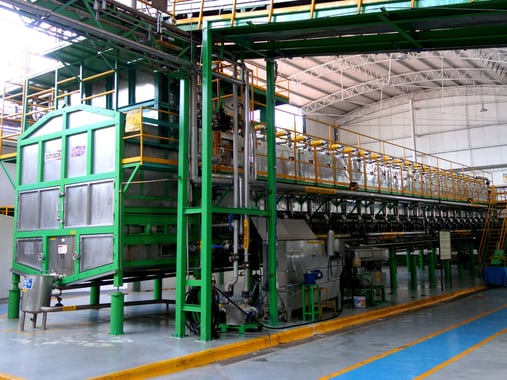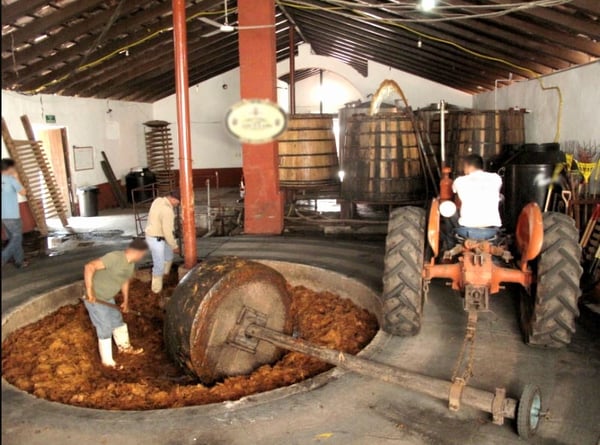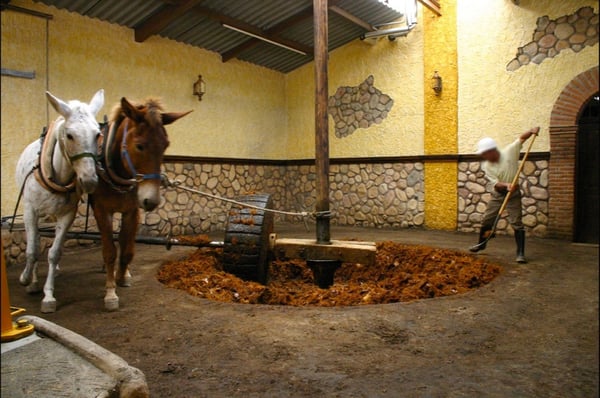 During my 20 years of experience in the tequila industry, one of the most frequently asked questions is, what is the best way to extract sugar from an agave? Many things could be improved on this subject. This article considers the pros and cons of the main processes.
During my 20 years of experience in the tequila industry, one of the most frequently asked questions is, what is the best way to extract sugar from an agave? Many things could be improved on this subject. This article considers the pros and cons of the main processes.
- Grinding in the tahona
- Mill grinding
- Smooth extraction in a diffuser
Agave grinding in the tahona for tequila
Remember that this is the oldest and therefore has certain disadvantages. One of them is that the process is outdoors. Suppose the surface for pressing is not uniform; it won't be easily cleaned later. In addition, stone and concrete have many pores, and difficult-to-remove contaminants can be stored in those holes.

Photo published by tequila sipper on his blog.
What kind of contamination can exist in the tahona pressing?
Contamination in this pressing can come from bacteria that settle on the surface. If the tahona has been pushed by tractors, these leave behind smoke and fuel contamination, which can even contaminate the sensory notes of the tequila. In addition to the above, it is common for personnel to step on the agave fiber with their shoes to accommodate it and continue the pressing process. Finally, if animals push the bakery, they leave bacteria in their way, contaminating the fibers.

Photo of the Tequila Regulatory Council.
What defects can a tequila have due to contamination?
The most common contamination is that generated by bacteria. However, once the contaminated juice is taken to fermentation, other types of unwanted products can be developed.
This type of unwanted product can generate notes that we consider defects, for example, notes with a very bitter taste. Another example is that lactic acid products have been developed that remain after fermentation and cannot be removed in the distillation process. This, at the sensory level, makes us have lactic or acid-lactic notes in the finished product, coming from that possible contamination due to not having the proper care.
Grinding of the agave through a mill
Remember that metal rollers press the agave fiber in the mill to extract its juice. Pressing the masses on the thread, the pressing can remove bitter notes carried to the fermentation and affect the finished product at a sensory level.
We can observe this in other processes of alcoholic beverages such as wine, for example, where an intense pressing of the grapes results in a poor-quality wine. This type of process or strong pressing bitters the juice, generating a different product than desired. A ubiquitous and easy-to-understand example is that of a grapefruit that, when squeezed with solid pressure, can make the juice bitter and give unpleasant notes.
Disadvantages of the traditional agave pressing process
There are some disadvantages to the traditional process. We could divide those disadvantages into the following categories:
- Disadvantages of maintaining quality
- Safety drawbacks
- Productivity Disadvantages
- Energy Disadvantages
- Disadvantages of equipment maintenance
Disadvantages of the traditional process in maintaining quality
Maintaining uniformity in quality in the traditional process is much more complex than cooking the piña to the agave. Whether in ovens or an autoclave, there are areas where the heat is more concentrated than in other parts. Although, therefore, the distribution of heat is not one hundred percent uniform, from there, we obtain some moles, fibers, or pieces of agave that is not so well cooked, which at the end of the extraction process, generate juices whose quality is different from those that had adequate cooking.
Innocuos disadvantages in the traditional process
The use of fats that are not food grade and that the juice may come into contact with it and become contaminated.
Productivity disadvantages in the traditional process
In the traditional process, less sugar is used since the remains of bagasse contain sugars that are discarded along with the fibers. On the other hand, in the soft extraction process, the pineapple fibers are left with fewer residual sugars.
Energy disadvantage in the traditional process
The power required to operate a grinding train is around 40% greater than a diffuser needs, saving us electricity consumption.
The disadvantage of maintenance in the traditional process
In the case of mills, the wear of the equipment is more aggressive than the wear on equipment such as the soft extraction diffuser. The mills constantly have to be maintained because the grooves of the cylinders wear out in the pressing due to contact with the fiber. At the maintenance level, the grinding process for its equipment has a higher cost than a diffuser piece.
Using more modern processes, such as the gentle extraction of sugar, has fewer disadvantages than the traditional process, offering a product with consistent quality and without sensory defects.
Do you want to know more about the advantages of the delicate extraction process for sugar extraction from the agave? Then, read my next article, where I touch on this process in more detail.
We invite you to come to Casa Sauza and learn more about us and our tequila production processes.
.png?width=50&height=50&name=10.CS-Redondo%20(1).png)
 Rodrigo Nájar
Rodrigo Nájar
